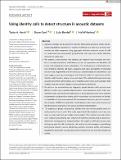Files in this item
Using identity calls to detect structure in acoustic datasets
Item metadata
| dc.contributor.author | Hersh, Taylor A. | |
| dc.contributor.author | Gero, Shane | |
| dc.contributor.author | Rendell, Luke | |
| dc.contributor.author | Whitehead, Hal | |
| dc.date.accessioned | 2021-05-31T15:30:04Z | |
| dc.date.available | 2021-05-31T15:30:04Z | |
| dc.date.issued | 2021-05-29 | |
| dc.identifier | 274358578 | |
| dc.identifier | 2feaf8aa-8ed4-4b3a-bcd0-429625a64a1c | |
| dc.identifier | 85106676927 | |
| dc.identifier | 000655875900001 | |
| dc.identifier.citation | Hersh , T A , Gero , S , Rendell , L & Whitehead , H 2021 , ' Using identity calls to detect structure in acoustic datasets ' , Methods in Ecology and Evolution , vol. Early View . https://doi.org/10.1111/2041-210X.13644 | en |
| dc.identifier.issn | 2041-210X | |
| dc.identifier.other | RIS: urn:863B909014F6C47736640F73A0C7995D | |
| dc.identifier.other | ORCID: /0000-0002-1121-9142/work/95041840 | |
| dc.identifier.uri | https://hdl.handle.net/10023/23286 | |
| dc.description.abstract | 1. Acoustic analyses can be powerful tools for illuminating structure within and between populations, especially for cryptic or difficult to access taxa. Acoustic repertoires are often compared using aggregate similarity measures across all calls of a particular type, but specific group identity calls may more clearly delineate structure in some taxa. 2. We present a new method-the identity call method-that estimates the number of acoustically distinct subdivisions in a set of repertoires and identifies call types that characterize those subdivisions. The method uses contaminated mixture models to identify call types, assigning each call a probability of belonging to each type. Repertoires are hierarchically clustered based on similarities in call type usage, producing a dendrogram with 'identity clades' of repertoires and the (identity calls) that best characterize each clade. We validated this approach using acoustic data from sperm whales, grey-breasted wood-wrens, and Australian field crickets, and ran a suite of tests to assess parameter sensitivity. 3. For all taxa, the method detected diagnostic signals (identity calls) and structure (identity clades; sperm whale subpopulations, wren subspecies, and cricket species) that were consistent with past research. Some datasets were more sensitive to parameter variation than others, which may reflect real uncertainty or biological variability in the taxa examined. We recommend that users perform comparative analyses of different parameter combinations to determine which portions of the dendrogram warrant careful versus confident interpretation. 4. The presence of group-characteristic identity calls does not necessarily mean animals perceive them as such. Fine scale experiments like playbacks are a key next step to understand call perception and function. This method can help inform such studies by identifying calls that may be salient to animals and are good candidates for investigation or playback stimuli. For cryptic or difficult to access taxa with group-specific calls, the identity call method can aid managers in quantifying behavioural diversity and/or identifying putative structure within and between populations, given that acoustic data can be inexpensive and minimally invasive to collect. | |
| dc.format.extent | 11 | |
| dc.format.extent | 1420962 | |
| dc.language.iso | eng | |
| dc.relation.ispartof | Methods in Ecology and Evolution | en |
| dc.subject | Bioinformatics | en |
| dc.subject | Community ecology | en |
| dc.subject | Conservation | en |
| dc.subject | Diversity | en |
| dc.subject | Population ecology | en |
| dc.subject | QH301 Biology | en |
| dc.subject | 3rd-DAS | en |
| dc.subject.lcc | QH301 | en |
| dc.title | Using identity calls to detect structure in acoustic datasets | en |
| dc.type | Journal article | en |
| dc.contributor.institution | University of St Andrews. School of Biology | en |
| dc.contributor.institution | University of St Andrews. Centre for Social Learning & Cognitive Evolution | en |
| dc.contributor.institution | University of St Andrews. Centre for Biological Diversity | en |
| dc.contributor.institution | University of St Andrews. Sea Mammal Research Unit | en |
| dc.contributor.institution | University of St Andrews. Bioacoustics group | en |
| dc.contributor.institution | University of St Andrews. Marine Alliance for Science & Technology Scotland | en |
| dc.identifier.doi | https://doi.org/10.1111/2041-210X.13644 | |
| dc.description.status | Peer reviewed | en |
This item appears in the following Collection(s)
Items in the St Andrews Research Repository are protected by copyright, with all rights reserved, unless otherwise indicated.

